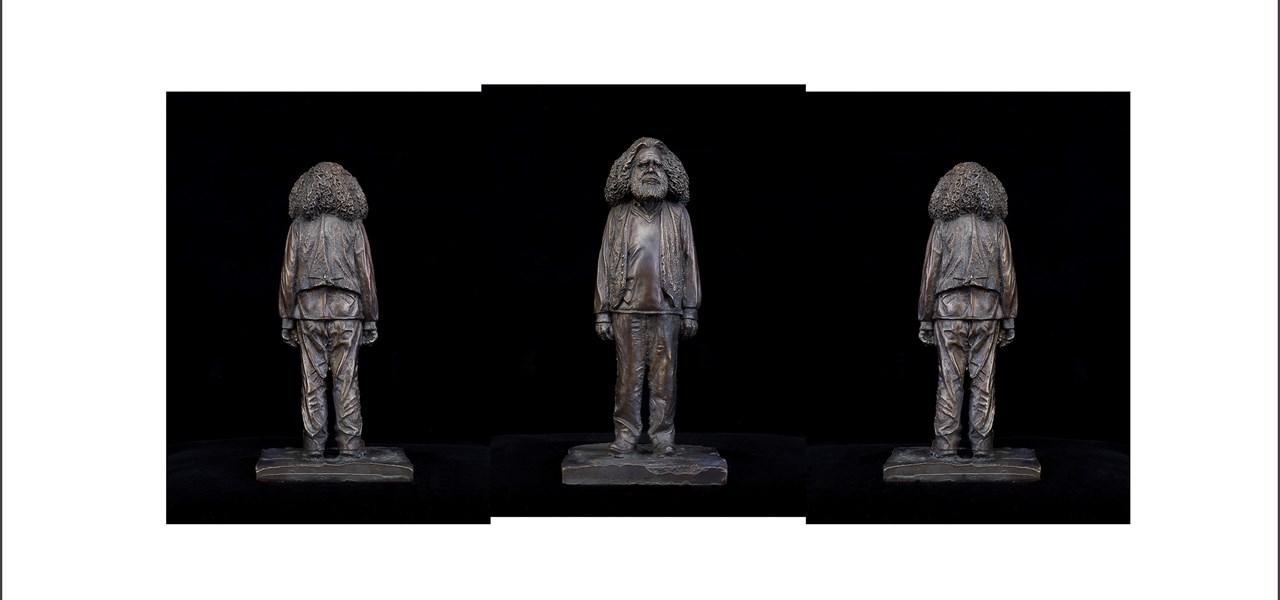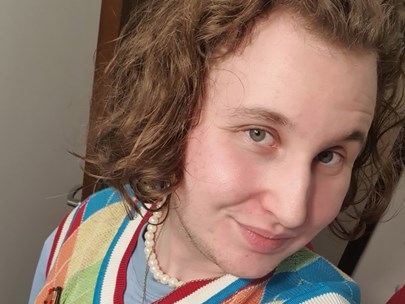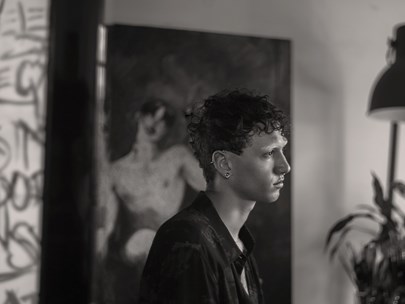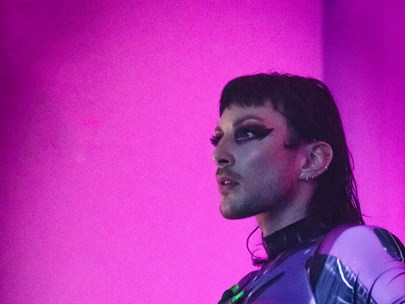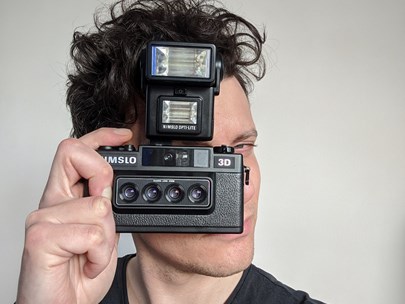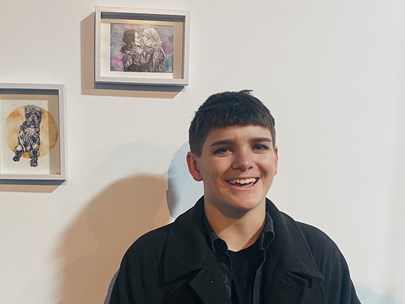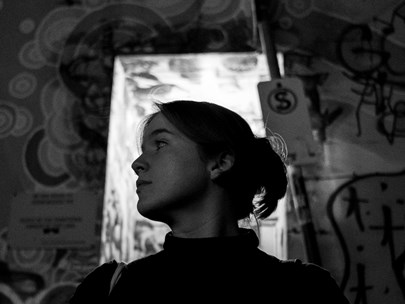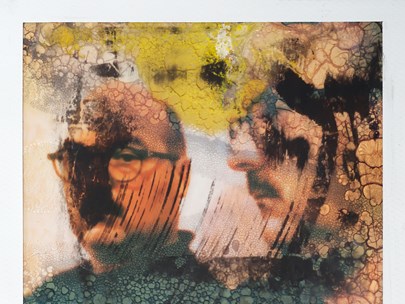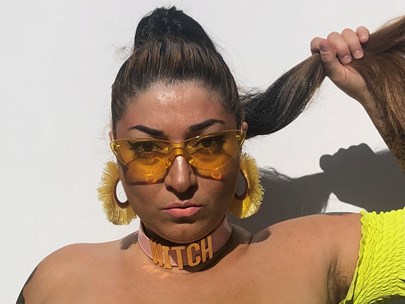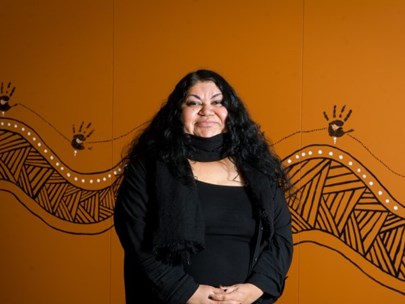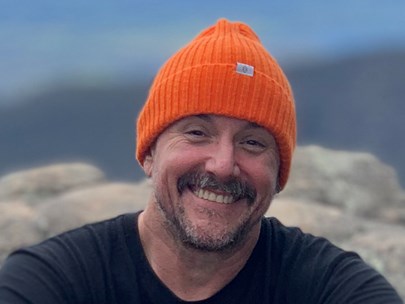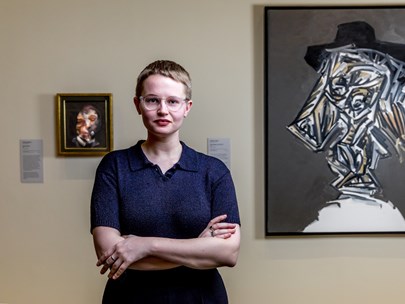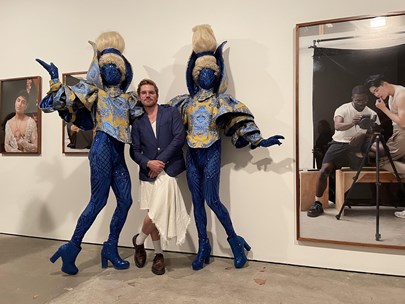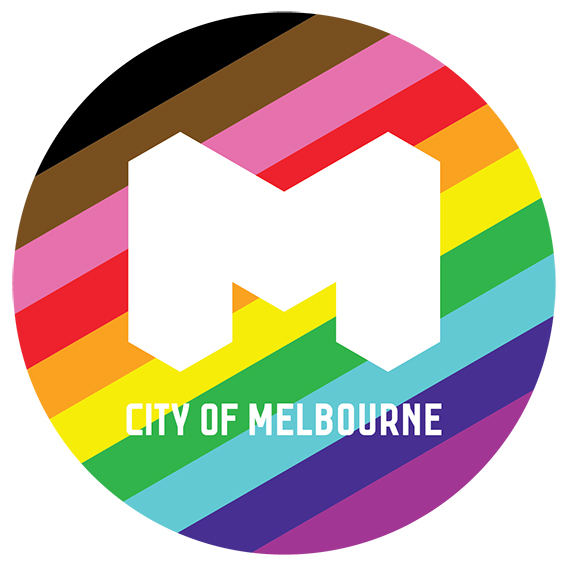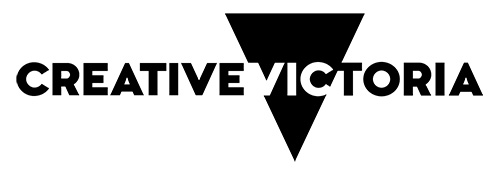Midsumma and Australia Post Art Award - 2023 Finalists
2023 main award winner: 'National Treasure' (Uncle Jack Charles) by Leonie Rhodes
2023 Finalists
Alun Rhys Jones (he/him)
Self-Portrait Series (2021)
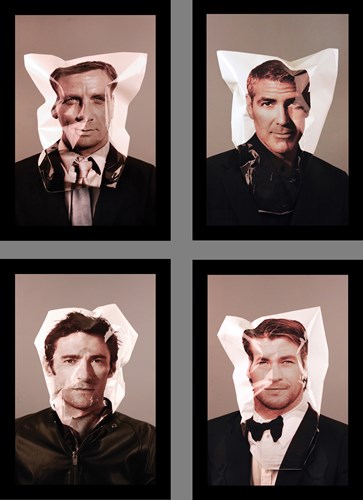 Digital prints on Fuji (Metallic) paper. Edition of 10.
Digital prints on Fuji (Metallic) paper. Edition of 10.
Celebrity surrounds us, from film to sports, from Facebook to fashion, from TV to Twitter, permeating our lives with a glamorous, dazzling allure of chance and possibility.
But beyond this glittering surface, celebrity reveals key insights into how we see ourselves; our psychological desires, social needs and economic wants. Who we admire, model ourselves upon and aspire to be, reveal what we think about ourselves on a deep and profound level.
Celebrities are revered with a Godlike status possessing a cultural authority to act as spokespeople, commentators, role models, brand ambassadors and political advocates. They serve for many as the arbiters of taste, morality and public opinion. Celebrity illuminates massive shifts in contemporary culture, and plays a key role in shaping todays world through consumerism, the media and politics.
The Self-portrait series of four photographs are all concerned with the depiction of masculinity, celebrity and image in mainstream media. The titles of the works include “Self-Portrait as the Sexiest Man Alive” and “Self-Portrait as the Most Beautiful Man in the World”and are concerned with the aspirational nature of marketing and celebrity endorsement.
Caleb Hardy (he/him)
Dog Days (2022)
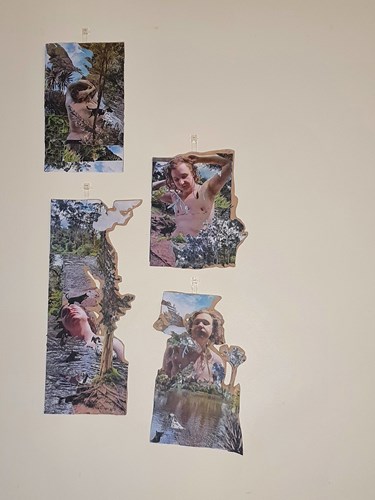 Cartridge paper collage on wooden panel.
Cartridge paper collage on wooden panel.
'Dog Days' is a quadriptych series that engages with abstract representations of the memory of first summer day the artist had shirtless post top surgery. It was not planned, but rather out of necessity to retrieve his dog who had wandered too far into the Warrandyte River and needed guidance navigating brimming with people and dogs swimming on that hot day. In removing my shirt, I was met with a variety of stares which I could have read in many ways but rather let that wash over me in the moment. Instead, I opted for channeling my focus into those who took to me kindly, but more so into the natural surroundings and carefree nature of the dogs as evident in the selection and omission of subjects in this memory recreated.
Kyle KM (he/him)
HIM (2021)
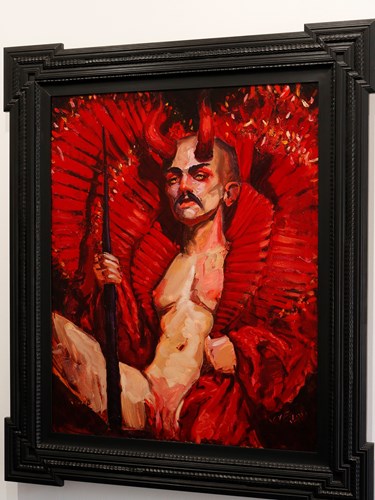 Oil on canvas.
Oil on canvas.
'HIM' features trans activist and model Hotboiyo.
The sitter and artist played through Rose Chong costumes until the artwork themes organically evolved through Hoboiyo's excitement and a collaborative natural expression of power in his own reflection.
Channeling references of Velasquez' "Pope Innocent X", Power Puff Girls' "HIM", and more Kyle expresses a chaotic expression of controlled power. The looseness of brush strokes contrasted with the controlled clean gaze of the glowing eyes HIM stares out of the painterly inferno with the unwavering right to exist.
Asking not for space in this world but owning every breath without fault.
The bespoke frame is presented by Rich & Davis Artisan Frame Makers.
Lachlan Purcell (he/she/they)
Brunswick Baby (2021)
Video.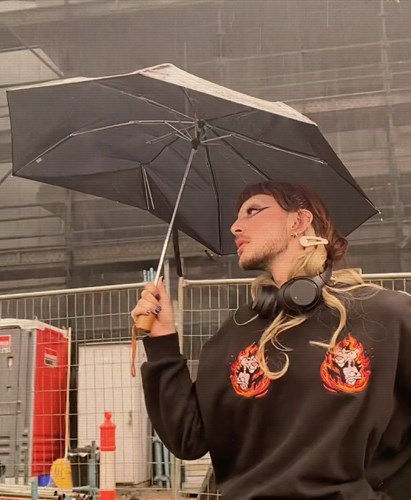
Brunswick Baby is a house tour of sorts. Made in Loxy's share house soon after moving in, this video paints existentialism in the most fashionable of lights. Loxy took inspiration from spoof music videos he watched whilst growing up. And borrowed other elements from pop-culture gems, namely drag and Lana Del Ray. In this work Loxy hopes to both celebrate and satirise his lifestyle, without being to specific about what part is which.
Leonie Rhodes (Leonie) - Main Award winner
'National Treasure' (Uncle Jack Charles)
 Solid Silver.
Solid Silver.
Uncle Jack Charles was a respected aboriginal elder, a Bunerong, Boon Wurrung, Yorta Yorta, Palawa, Wurundjeri, Tungerong man, and an internationally acclaimed actor, mentor and activist. This inspirational, Indigenous gay man was part of the stolen generation and was taken from his family as a tiny baby. He survived the impact of this early childhood trauma by using drugs. Without support or housing, he was often homeless and imprisoned for long periods of time and true artistic recognition came only later in life.
Uncle Jack made profound and lasting change in legislation and public awareness on Aboriginality, criminality, and social justice in Australia. After his death there was a vast outpouring of grief across the country. Leonie is working with the Charles family to help continue growing his legacy which continues to positively impact the lives of thousands of people.
Often the most talented members of our community struggle with addiction and homelessness. This piece asks us to take a closer look at the way the state criminalises human responses to trauma, which the state itself often inflicts, willing us to face history more bravely and to treasure people sooner.
Logan Mucha (he/him/they) - Bundoora Art Prize Award winner
I can’t remember how to dance at nightclubs (2022)
 Single Channel Video, Sound.
Single Channel Video, Sound.
This video artwork documents a fragmented, communal memory of queer venues and their historical role in forging community. The nightclubs that defined my youth and queer identity have long since closed but are now preserved as 3D models, reconstructed with photogrammetry techniques that analysed thousands of location-based photos. These virtual tombs question the enduring legacy of such spaces as digital technology and lockdowns radically alter our means of connection.
Lucy Donovan (they/she)
Bury Your Gays (2018 - ongoing)
 Ballpoint pen on paper.
Ballpoint pen on paper.
This is a large-scale ongoing drawing project that explores the broad spectrum of LGBTQIA+ identity and how it has been written and presented in serial television programs. In particular, this project explores how the representation of sapphic, queer, bisexual, and lesbian presenting women and non-binary characters often fall to a reoccurring narrative pattern that has been present for decades in television media. This pattern, or 'trope', is known as 'Bury Your Gays'. This project is physical documentation of how Bury Your Gays has been represented in violent, solemn and impactful ways across screen media, and how their final moments on screen plays out. This project is ongoing for as long as television media continues to kill queer characters as a plot device or to further other characters' development arcs. It will never truly capture the impact of the extent of all media, nor the impact of more commonly seeing the characters you look up to die, rather than get a happy ending.
Margot Stewart (she/her)
Gooch - from the series "The Second Flesh" (2022)
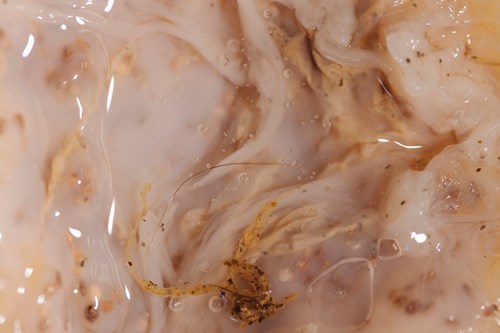 Digital photographic print.
Digital photographic print.
"The Second Flesh" is an alternative approach to imaging the female body, providing a means to avoid the commodifying gaze. Consisting of grotesque, fleshy, almost ‘internal’ imagery, the work intends to flip traditional viewing strategies - focusing on grotesque internal-like imagery instead of the culturally expected external appearance of the body. Seeking to both sexually allure and repulse, “The Second Flesh” supplies an unexpected view of the body that cannot be commodified or sexualised, dissolving hierarchies of looking. "The Second Flesh" is an ongoing Honours year project, supervised by Ray Cook at RMIT University.
Matthew Schiavello (he/him)
'NYC #26, Feb 2022' (2022)
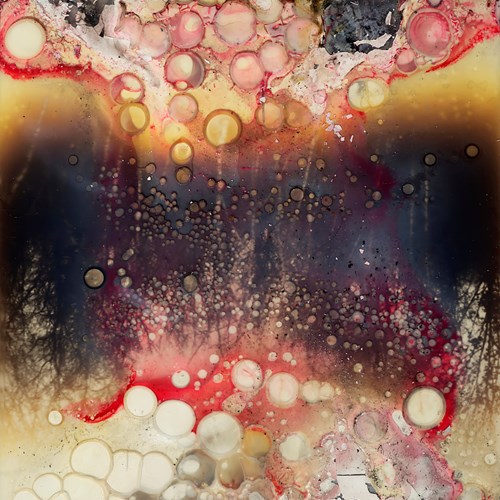 Archival Digital print. (framed).
Archival Digital print. (framed).
In the work ‘NYC #26, Feb 2022’, Matthew explores the boundaries of traditional photography as he interacts with Polaroid prints of his work in various ways. With NYC#26, Feb 2022, Matthew alters the print by first soaking it in a peroxide solution, then he injects the print with watercolour paints and then soaks it in bleach. Though altered by this process and having aspects of the original imaged damaged and/or removed, something beautiful and different is found.
This in a way, mirrors Matthew's journey in life as a maturing gay man, affected and altered by society. Like many LGBITQ+ people, as a younger person he was subjected to physical and psychological attacks. These lead to him feeling he had to mask his true self to remain safe. As he ages he recognizes his strength, his resilience, and the beauty in who he is and in who he has become.
Due to the non archival method involved and the fact that the modified prints become fragile and are in an ongoing state of decay, Matthew captures the work digitally. He presents an enlarged, digital 'test' print of the work.
Noah Spivak (he/him)
we who sit but cannot sit still (waverley V) (2022)
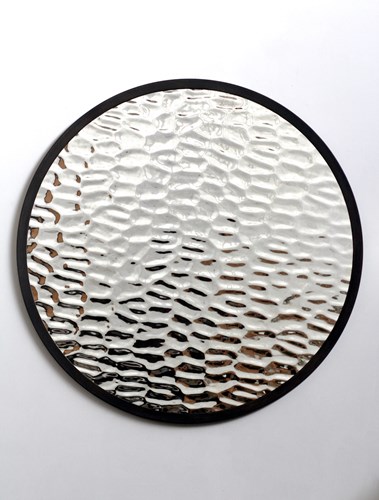 Hand silvered glass, black oxide, steel.
Hand silvered glass, black oxide, steel.
Spivak’s silver works investigate the liminal space between narcissism and self-loathing. A fragile landscape that shapes humanity with its relentless ability to create distance between the perceived and created self. The hand silvered glass panels are made via a process reminiscent of 18th century alchemy. These far from perfect “mirrors” reflect and disillusion both the physical and mental space of their admirers – reminding each of us of our own fragile dance with confidence and criticism.
For the artist, it suggests the powerful duality of narcissism over his own identity - the created and perceived self - existing together in one space but impossibly so. Spivak uses this opportunity to publicly gesture towards his own issues in confidence, delusion and their respective relationships to self/image.
Raphy (he/him)
Crabs #1 & #2 - from the series "STI's I've Had, A Ceramic Journey to Queer Sexual Health (2022)
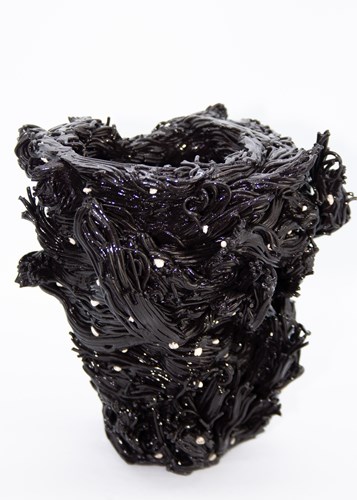 Mid-fire Clay and porcelain.
Mid-fire Clay and porcelain.
Crabs #1 and Crabs #2 are both taken from ‘STI's I've Had, A Ceramic Journey to Queer Sexual Health’.
Crabs #1 depicts long strands of black clay, interrupted by specks of white porcelain. Representing the tornado of fear and dread one can feel upon finding out they are infested with crabs.
Crabs #2 depicts a grotesque, functional vase in the form of a hairy leg that is covered in crab eggs. Reminiscent of the artist’s own experience discovering crabs living on his legs and the sense of disgust that followed.
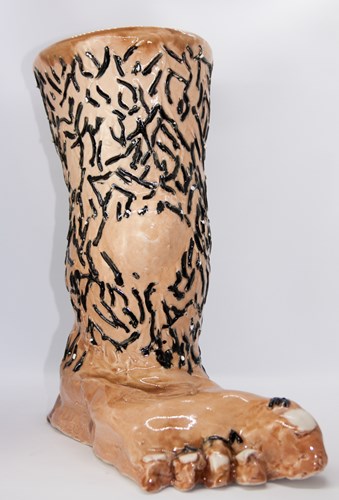 STI’s I’ve Had: A Ceramic Journey to Queer Sexual Health is a collection of surrealist vessels that tell the story of Raphy’s experience accessing sexual health screening and treatment over the years.
STI’s I’ve Had: A Ceramic Journey to Queer Sexual Health is a collection of surrealist vessels that tell the story of Raphy’s experience accessing sexual health screening and treatment over the years.
Inspired by the term ‘vessel’ to both refer to objects thrown on the wheel that carry water and also our bodies which carry disease and infections, the collection is a series of vessels that depict the various STI’s Raphy has encountered and are accompanied by a story for each.
Contending that young queer people are not taught how to seek out appropriate help for these infections and must usually rely on a ‘whisper network’ for vital health information, STI’s I’ve Had aims to address the often mysterious, scary and heavily stigmatised world of sexual health through a humorous, surreal lens.
Narration can be found at the Soundcloud link provided.
Sammaneh Pourshafighi (she/he/they)
Reconnected To Myself And The Ancestors Through The Act of Washing My Body (2021)
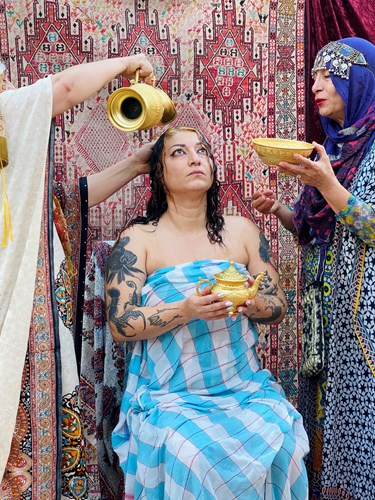 Photographic print on archival paper.
Photographic print on archival paper.
My family and I came to Australia as refugees from Iran. As part of a diaspora, I am constantly trying to find a place as a queer, Muslim and Persian person living on unceded, stolen, indigenous land. For as many moments of struggle that exist in this experience, there are moments of joy, quiet introspection and pride. The Covid-19 pandemic has added more layers of complexity to my experience especially around the importance of nurturing and maintaining connections to my social communities, cultural background, traditional rituals, and my family both living and ancestral.
Converging in my parents’ garden following six months of COVID-19 lockdowns spent apart, I am both the subject and object of the artwork. I am captured in an Islamic-style ritual as my maternal aunt and mother tenderly wash my body. Equal parts celebration, act of love and spiritual cleansing, the ritual marks a powerful reconnection of physical community ties in a post-pandemic world.
Sian Harris (she/her)
Parnpa pitha (Choke) (2021)
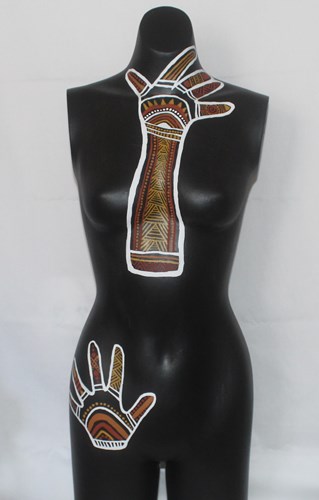 Mixed Media.
Mixed Media.
Aboriginal art can and should explore the gamut of human experience, just like other styles do, thus stepping away from often sanitised versions of voice and truth. We deserve to depict the horny stuff, too. Parnpa pitha (choke) is my story of intimate BDSM as a Blak woman who loves women and gender diverse people.
Vince Partington (he/him/his) - People’s Choice Award winner
PIRNBIAL (2021)
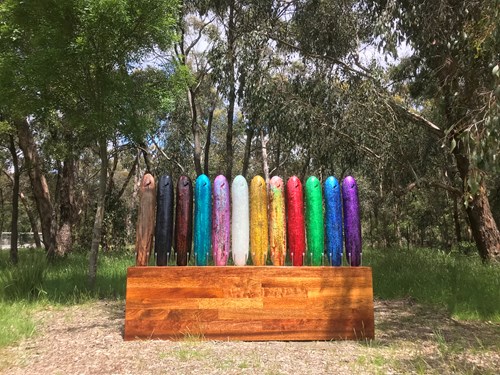 Timber & Resin Sculptures.
Timber & Resin Sculptures.
The name of the work is Pirnbial in the Woi-Wurrung language (Rainbow in English). The hand finished Gayaam (shield) was carved from an old dead Stringybark at Vince's home on country in Ballarat. The carved work was then moulded in rubber. Finally, Vince cast the Gayaam out of clear casting resin eleven times. Each cast has a different colour and matching glitter mixed into the resin. The colours represent the eleven colours of the Progress Pride Rainbow Flag. Vince chose the Gayaam as a protective totem that symbolises family. Family, that has always protected and embraced Vince and each other regardless of gender or sexual identity.
The finished Gayaam are mounted in a line on a plinth to catch the light and make them sparkle. The glitter is the pure representation of what it means to be gay. Shining brightly in the face of adversity. PIRNBIAL has been exhibited 3 times already with great success. Vince questions that there is enough artwork out there that represents his place in the world. Vince's hope is that people visiting the artwork will contemplate, discuss and hopefully explore further the rich and ancient culture and history surrounding the Kulin Nations first peoples, its lands, waters and languages.
The 2023 Judges
Meg Slater (she/they)
Meg Slater (she/they) is Curator, International Exhibition Projects department at the National Gallery of Victoria (NGV). Since 2017, Meg has worked on a number of the NGV’s major international exhibitions, including MoMA at NGV: 130 Years of Modern and Contemporary Art, French Impressionism from the Museum of Fine Arts, Boston and the forthcoming Pierre Bonnard: Designed by India Mahdavi. Meg was also one of the five curators who organised QUEER: Stories from the NGV Collection (2022), the most historically expansive thematic presentation of its kind ever presented by an Australian art institution. In 2021, Meg completed a Master of Art Curatorship at the University of Melbourne with First Class Honours. Meg's thesis explored the potential for large arts institutions to more meaningfully engage with marginal subjects and histories through exhibition making and programming.
Brendan McCleary
Born and living on Wurundjeri country, Brendan McCleary is the Curator at Photo Australia, currently working on PHOTO 2024 International Festival of Photography (1–24 March 2024). He has worked with artists such as Cindy Sherman, Paul Mpagi Sepuya, Thandiwe Muriu, Mohamed Bourouissa and Vasantha Yogananthan at PHOTO 2022, and Zanele Muholi, Hoda Afshar, Brook Andrew and Maree Clarke at PHOTO 2021. For PHOTO 2022, he curated Queering the Frame: Community, Time, Photography at the Centre for Contemporary Photography. Previously, Brendan worked as a Producer for MPavilion, stage managed events for White Night Melbourne, Dark Mofo and Melbourne Music Week, and in 2017 worked for the Australia Pavilion at the Venice Biennale. As an independent curator, Brendan has worked with a number of Australian and international artists including Carolee Schneemann and Allora and Calzadilla.
Jason May
Jason May is Australia Post’s representative on the Midsumma Australia Post Art Prize judging panel and is thrilled to be judging the art prize again for the second year. Jason has worked at Australia Post for seven years now and is also the Post Pride Victorian State Ambassador. PostPride drives positive change to promote diversity and inclusion of the LGBTQI+ community across the Australia Post enterprise. Jason is also an avid art collector and enjoys supporting and discovering new Australian artists across a variety of mediums. Both a previous winner and a finalist of this art prize are amongst his collection. He is also a proud Patron of the Midsumma Festival.

